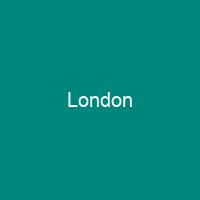London: The Heart of England and the United Kingdom
London, the capital city of both England and the United Kingdom, is a bustling metropolis with a population of 8,866,180 as of 2022. Its wider metropolitan area boasts an impressive 14.9 million residents, making it one of the largest urban areas in Western Europe.
For nearly two millennia, London has been a thriving hub, with its ancient core and financial centre, the City of London, founded by the Romans as Londinium around 47 AD. The city’s rapid growth in the 19th century saw it become the world’s largest metropolis at that time.
Today, London is not just a political and economic powerhouse but also a global leader in art, entertainment, fashion, commerce, finance, education, healthcare, media, science, technology, tourism, transport, and communications. Despite facing challenges post-Brexit, the city remains an economic force to be reckoned with.
With over 300 languages spoken, London is a melting pot of cultures, home to four World Heritage Sites and numerous landmarks such as Buckingham Palace, the London Eye, Piccadilly Circus, and St Paul’s Cathedral. The city also boasts more museums, art galleries, libraries, and cultural venues than any other in the UK.
From the FA Cup Final to Wimbledon Tennis Championships, and from the London Marathon to the Olympic Games, London hosts a plethora of significant sporting events that draw crowds from around the world. Its rich history is evident in its diverse architecture, ranging from ancient structures like the Tower of London to modern marvels such as The Shard.
The name ‘London’ has evolved over time, with roots in Common Brythonic and Latin adaptations. It initially referred only to the City of London but now encompasses the County of London and Greater London. This vast area covers 611 square miles (1,583 km2) and is home to a diverse population that speaks more than 300 languages.
History
Prehistory
In the prehistoric era, remains of a Bronze Age bridge were found on the south River Thames foreshore upstream from Vauxhall Bridge. Additionally, foundations of a large timber structure dating back to 4800–4500 BC were discovered downstream from Vauxhall Bridge.
Roman London
The Romans founded Londinium around 47 AD and it thrived until about 61 AD when Queen Boudica led a rebellion. The city’s next incarnation prospered in the 2nd century with an estimated population of 60,000.
Anglo-Saxon and Viking Period
The walled city of Londinium was abandoned after Roman rule collapsed in the early 5th century. An Anglo-Saxon settlement known as Lundenwic developed slightly west of the old Roman city. By about 680, London had become a major port again.
Middle Ages
After William I’s victory at the Battle of Hastings in 1066, he established the Tower of London and began building Westminster Hall. The City of London flourished under its own administration while the City of Westminster developed into a true governmental capital.
Key Events
- The Great Fire of London broke out in 1666 and swept through wooden buildings, leading to a decade-long rebuilding effort supervised by Robert Hooke.
- In 1710, St Paul’s Cathedral was completed, dominating the skyline for centuries.
- During the Georgian era, new districts like Mayfair formed, and the Port of London expanded downstream. London developed into an international financial centre in the 18th century.
Modern Era
In the early 20th century, London was plagued by disease, including the Great Plague of 1665–1666 and the Great Fire of 1666. The city also faced significant urbanisation during the Industrial Revolution, becoming the world’s largest city from 1831 to 1925.
During World War II, London was bombed extensively, leading to the creation of the London Underground for shelter and transportation. Post-war, the city became a hub for immigrants from Commonwealth countries, making it one of the most diverse cities in the world.
Government and Administration
The unique governmental status of London developed over time with the Corporation of the City of London making ‘The Great Refusal’ in 1637 to extend its jurisdiction. The city’s political boundaries were expanded in 1965, and it has since become a major hub for government departments including Parliament.
The Mayor of London oversees policing and crime, while the Metropolitan Police provide law enforcement except in the City of London, which has its own police force. Crime rates vary widely across different areas of London, with recorded crimes rising over time, particularly violent crimes.
Geography and Climate
Geography
London is situated on the River Thames, making it vulnerable to flooding due to climate change and post-glacial rebound. The city’s architecture is diverse, with many buildings constructed from Portland stone. Notable landmarks include the Monument commemorating the Great Fire of London, Nelson’s Column in Trafalgar Square, and the Barbican Estate.
Climate
The wettest year on record was 1903 with a fall of 38.1 inches, while the driest was 1921 with just 12.1 inches. London’s average annual precipitation is about 600mm, with an average of 109.6 rainy days annually. The city experiences temperature extremes ranging from -17.4°C to 40.2°C.
Population and Diversity
Diversity
London’s population is diverse, with over 300 languages spoken. According to the 2021 census, 40.6% of Londoners were foreign-born, with the largest single countries of origin being India, Romania, Poland, Bangladesh, and Pakistan.
Ethnicity
The city’s ethnic structure is as follows: White (53.8%), Asian or mixed-Asian descent (22.2%), Black or mixed-Black descent (15.9%), Mixed race (5.7%). London has a significant religious landscape, with Christians making up 40.66%, those of no religion accounting for 20.7%, Muslims at 15%, and Hindus at 5.15%.
Economy
Finance Industry
The finance industry is London’s largest, with its financial exports contributing significantly to the UK’s balance of payments. The city is the world’s biggest currency trading centre, accounting for 37% of daily volume.
Tourism and Entertainment
London is one of the leading tourist destinations in the world, with tourism employing 700,000 full-time workers and contributing £36 billion to the economy each year. Major attractions include the British Museum, National Gallery, Natural History Museum, and other popular sites.
Culture
LGBT Scene
London has a vibrant LGBT scene with significant cultural movements influencing its development. The first gay bar in London was established as a night club at 9 Heddon Street in 1912, and today, the annual London Pride Parade and the London Lesbian and Gay Film Festival are held in the city.
Literature, Film, and Television
London has been the setting for many works of literature, including Geoffrey Chaucer’s Canterbury Tales, William Shakespeare’s plays, and Daniel Defoe’s A Journal of the Plague Year. The city is also a major hub for film production with studios like Pinewood Studios and Ealing Studios.
Leisure and Entertainment
Parks and Recreation
London offers 35,000 acres of public parks, woodlands, and gardens. The largest parks include Hyde Park, Kensington Gardens, Regent’s Park, Green Park, St James’s Park, Hampstead Heath, and Richmond Park.
Annual Events
London hosts a variety of annual events such as the Notting Hill Carnival, the Lord Mayor’s Show, and the Trooping the Colour. The Boishakhi Mela is also celebrated by the British Bangladeshi community in London.
Sports
The most popular sport in London is football, with seven clubs in the Premier League and four teams in the Women’s Super League. Other sports include rugby union (two Premiership teams), tennis (Wimbledon Tennis Championships), cricket (Lord’s and The Oval), golf (the Open Championship at Royal St George’s), darts (the PDC World Darts Championship), and snooker (the Masters tournament).
London Marathon
The London Marathon is a mass-participation event that draws runners from around the world. The University Boat Race on the Thames also takes place annually, attracting thousands of spectators.
Museums and Cultural Institutions
Museums
London’s museums include the British Museum (7 million artefacts), National Gallery, British Library, Victoria and Albert Museum, Tate Britain, Tate Modern, Royal Academy of Music, Royal College of Music, Guildhall School of Music and Drama, and Trinity Laban conservatoires.
Music
The city is home to world-renowned orchestras like the London Symphony Orchestra, Philharmonia Orchestra, and Royal Philharmonic Orchestra. Concert halls include Barbican Arts Centre, Southbank Centre, Cadogan Hall, and opera houses such as the Royal Opera House.
Transport
Public Transport
The London Underground is the oldest and third-longest metro system in the world, serving 272 stations. The city’s bus network runs 24 hours a day with about 9,300 vehicles, over 675 bus routes, and about 19,000 bus stops.
London is a major international air transport hub with Heathrow Airport being the main hub of British Airways. Gatwick Airport handles more destinations than any other UK airport, while London Stansted serves the greatest number of European destinations.
Conclusion
London stands as a testament to human resilience and innovation, a city that has evolved from its ancient Roman roots to become one of the world’s most influential metropolises. Its rich history, diverse population, and vibrant culture make it a unique and captivating place. As London continues to grow and adapt, it remains at the forefront of global progress, inspiring generations with its enduring spirit.

You want to know more about London?
This page is based on the article London published in Wikipedia (retrieved on January 29, 2025) and was automatically summarized using artificial intelligence.







